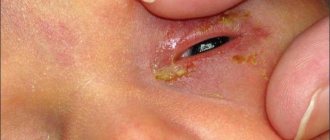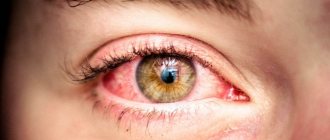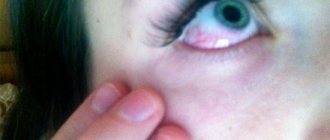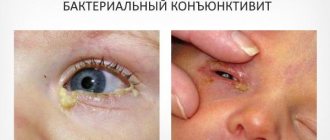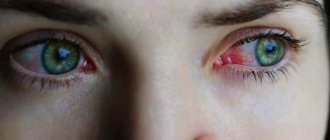Causes of redness of the sclera during ARVI
When suffering from ARVI (an infection that affects the mucous membrane of the upper respiratory tract), many patients experience redness of the sclera. Due to a runny nose and a strained cough, small blood vessels expand and sometimes burst. In addition, viruses also colonize the outer shell of the eye, causing inflammation and, accordingly, redness of the protein.
Causes of red eyes in a patient:
- conjunctivitis;
- keratitis (inflammation of the outer membrane of the eye);
- acute inflammatory diseases (eyelid abscess, barley, etc.);
- allergic reaction;
- not only ARVI, but also exposure to cigarette smoke, incorrectly selected lenses;
- glaucoma or subconjunctival hemorrhage;
- damage to the vessel, which leads to the accumulation of blood between the sclera and conjunctiva;
- high blood pressure.
Conjunctivitis is caused by a virus, bacteria or allergy. The causative agents are Koch-Wicks bacillus, pneumococci, streptococci and staphylococci. Exogenous infection of the conjunctiva is observed, including through contaminated hands. Conjunctivitis is the main reason why the whites of a person's eyes turn red.
During the illness, the mucous membranes are affected. Tearfulness, itching, burning, photophobia and swelling of the eyelids occur. To become infected, it is enough to rub your eyes with dirty hands and introduce staphylococci or other bacteria. The situation becomes more complicated if the patient wears contact lenses or frequently rubs his eyes. You may also experience: inflammation of the mucous membrane of the eye, burning and dryness, photophobia.
IMPORTANT! Redness of the sclera can appear not only with ARVI, but also with influenza. The infection affects not only the epithelium of the respiratory tract, but also the eyes - the capillaries dilate and become visible on the white of the eyeball.
Why does the symptom occur in a child?
Children also suffer from red eyes if they become ill with ARVI, as well as whooping cough or measles. In the case of adenovirus infection, the respiratory system is affected in the upper sections, which have close communication with the eye conjunctival sac.
Measles also negatively affects the capillary vascular system, causing redness of the eyeballs. The disease affects the capillary system of blood vessels, causing prolonged spasms and redness of the eyeballs.
Redness of the eyes is accompanied by a runny nose and other unpleasant symptoms. With whooping cough, severe coughing can also cause sclerotic vessels to burst, causing the eyes to become red and watery, and the eyelids to swell.
Unlike ordinary ARVI, with whooping cough the eyes literally become bloodshot. In addition, the jugular veins in the child’s neck swell. The whole face also turns red, not just the sclera. Even newborn babies can have red eyes. In the first three months, dacryocystitis may also be detected, in which purulent discharge from the eyes is observed.
The reason is poor patency of the tear duct. In newborns, redness of the eyes can also be a consequence of infection during passage through the birth canal. Therapy for adults and children is slightly different. For children, Albucid solution and other cold remedies are prescribed to relieve eye pain. A chamomile compress is also used to relieve irritation and discomfort.
Why do your eyes hurt when you have a cold?
To understand why the eyes are the first to react to disease, you need a general understanding of their structure and location.
The human eyes are a paired organ that is located in the eye sockets of the skull and consists of the eye itself, connected via the optic nerve to the brain, and auxiliary apparatus (eyelids, muscles, lacrimal organs). The eyes are sensitive to the smallest changes, this applies not only to external stimuli, for example, the constriction of the pupil to light and its dilation to darkness, but also to internal processes. Multiple nerve endings, fibrous fibers of the anterior chamber of the eye, and venous plexuses maintain ocular pressure. All information received from the outside first falls on a nerve impulse, and then along the visual-nervous pathway is transmitted to the occipital lobe of the brain, where visual images are formed.
Attention! The slightest fluctuations in temperature, pressure, infection affect the nutrition of the eye and lead to unpleasant sensations.
A viral infection, entering the body, leads to destruction in several directions:
- Actively reproduces, releasing toxins. In this case, decay products enter the bloodstream, settle on the muscles (including the eye muscles), and the eyes experience discomfort.
- The infection leads to swelling of the mucous membranes, which spreads into the nose. Fluid accumulates in the sinuses, puts pressure on their walls, and since they are located next to the visual organs, it provokes pain in the eyeballs.
You must understand that pain in the eyes is not a disease, but only one of the symptoms of the disease, so drops and tablets will not solve the problem. In case of influenza and acute respiratory viral infections, it is better to take a sick leave to rest at home for a while. Having defeated the fever, the pain in the eyes will go away on its own.
It's not just a cold that hurts your eyes. Imagine that you skate for a long time on only one leg, after some time it will hurt from muscle overstrain. The eye muscles also get tired if you monotonously work at the computer, read, or watch TV. Prolonged tension of the eye muscles in adults leads to dryness, irritation, you don’t want to move your eyes from side to side, you want to cover them and not strain them.
Cold symptoms
A cold is accompanied by a headache, conjunctivitis, and they, in turn, provoke unpleasant sensations in the eyes:
- burning;
- itching;
- it hurts to move your eyes;
- dryness;
- pain;
- fear of light;
- decreased physical activity;
- redness.
Associated symptoms
Redness of the eyes is accompanied by other symptoms: fever, runny nose, cough. If conjunctivitis is diagnosed, the patient may still experience profuse tears, a feeling of a foreign body in the eyes, and a feeling of glued eyelashes in the morning. But there can also be complications. If the eye flu has damaged the cornea, there may be pain, twitching of the eye and severe fever, requiring more serious treatment.
ARVI is also characterized by symptoms:
- sore throat;
- redness and sore throat;
- dry, intermittent cough with sputum;
- feelings of general intoxication.
Redness of the eyes appears only if a bacterial infection is associated with the disease. With eye flu, inflammation of the mucous membrane of the eyes (keratitis) may also occur. Severe forms of the disease are observed mainly only in the case of an epidemic of colds.
Soreness
During illness, the body is greatly weakened. The patient may feel lethargic, tired, and have sore eyes due to the spread of the virus in the body. Toxins even penetrate into the muscles of the body, weakening them. The mucous membrane of the nose swells, pain appears in the frontal part of the head and around the eyes.
Eye pain may include:
- like a sensation of a foreign body, sand;
- excessive dryness, causing itching;
- feeling of stickiness due to purulent discharge.
Migraines may worsen when turning or tilting the head. It is recommended to drink as much warm liquid as possible and take medications that reduce fever and treat a runny nose. During illness, pain may radiate to the head and some areas of the face (if the trigeminal nerve is affected).
Expert opinion
Kim Oksana Alexandrovna
Head of the ophthalmology clinic. Ophthalmologist with more than 10 years of experience.
In particularly difficult cases, headaches intensify with exacerbation of the disease and may be accompanied by nausea and vomiting. There may be dizziness and even loss of consciousness. The temperature during ARVI can rise to 38°C on the first day, but does not stay high for long.
Tearing
With ARVI, due to intoxication of the body, the eyes may water all the time. When moving the eyeballs, painful sensations, photophobia, and burning may occur. Tearfulness usually begins due to a severe runny nose and cough, when the nose is stuffy and the nasopharyngeal mucosa is swollen. Red and constantly watery eyes during ARVI lead to the fact that it becomes difficult to work at the computer or look at the light.
A complication can lead to epidemic keratoconjunctivitis. Not only uncontrollable tears occur, but also a sensation of a foreign body in the eyes, swelling of the eyelids, redness of the mucous membrane, eyelids, photophobia, and decreased clarity of vision. At first, all these symptoms may occur in one eye, and then move to the second.
Swelling
During a cold, swelling of the nasal mucosa with impaired nasal breathing is observed. The eyelids also swell and bruises appear under the eyes. With conjunctivitis of a viral and microbial nature, the eyes swell due to the accumulation of inflammatory fluid. Swelling of the eyelids can also occur if you frequently touch your eyes and wipe them with a tissue.
Swelling is observed:
- century;
- tonsils;
- mucous membrane of the nose or eye.
During ARVI, not only does capillary permeability increase and swelling of the mucous membrane and nasal turbinates develops, but breathing becomes difficult, nasal discharge and other unpleasant symptoms appear. When a cold worsens, an abscess occurs in the lacrimal sac and eyelid, and pus accumulates in the eyes. Swelling of the entire face may be observed, especially in case of impaired nasal breathing, and an increase in the size of the cervical lymph nodes.
Swelling of the nasal cavity during ARVI lasts throughout the entire period of the disease. Vasoconstrictors can minimize swelling and improve the flow of mucus from the paranasal sinuses. This is very important as it reduces the risk of sinusitis and other complications.
Swelling around the eyes can also occur for reasons unrelated to ARVI. The reason may be high salt intake, which retains water in the body, or high fluid intake at night. A separate topic: swelling due to kidney problems, when metabolism and moisture release through the kidneys and urinary tract are disrupted. In addition, swelling can be a manifestation of allergies.
Purulent discharge
Purulent episcleritis is most often a symptom of staphylococcus infection. It is better not to start the disease and immediately consult a doctor so that it does not become chronic. With conjunctivitis, mucus is also sometimes released (with bacterial conjunctivitis - mixed with pus). This makes it hard to open your eyes in the morning. With allergic conjunctivitis, practically no mucus is secreted.
Main features
Red eyes during ARVI are the main symptom, however, it is also accompanied by some other symptoms that you should pay attention to:
- A burning sensation in one or both eyes.
- Slight redness of the whites.
- Arbitrary secretion of tears when they roll out of the eyes without the person’s knowledge.
- Photophobia occurs because it is quite difficult to look at the light.
If you notice one or more of the above symptoms, you should seek medical help. After the examination, appropriate medications will be prescribed that will eliminate the redness and get rid of the viral infection.
How to treat an adult
To remove redness and swelling of the eyes, you must first eliminate the cause of the disease. For this purpose, medications and other means are used: etiotropic and pathogenetic drugs that affect the virus or block enzyme systems that allow it to multiply. At the same time, eye drops and other medications are used to alleviate negative symptoms in the eye area.
For treatment you need:
- disinfect hands;
- lie down in a horizontal position and let the drops drop into your eyes or do it yourself.
To treat viral eye diseases, recombinant interferon eye drops are required. In addition to interferon, the drug contains the antiallergic drug diphenhydramine, which reduces swelling and itching. You need to instill 1-2 drops of the drug into each eye up to 6-8 times a day.
For bacterial conjunctivitis, broad-spectrum antibiotics are used (in the form of eye drops and ointments). When instilling eye drops, you need to pull back the lower eyelid and use your other hand to drip in the drops. Redness of the eyes does not require special treatment other than rinsing with a solution or drops. In a couple of days, immunity is developed, and the body is able to cope with inflammation on its own.
Vasoconstrictor drops with an alpha-adrenergic agonist narrow the capillaries of the sclera and conjunctiva. The drugs are used for conjunctivitis of various origins and inflammation of the eye mucosa during colds. If the cause is blepharitis, then apply warm compresses.
General principles of therapy
Umifenovir, oseltamivir and zanamivir are used for treatment, which are preferably used within the first two days from the onset of the disease. Etiotropic therapy shortens the duration of the disease, removes symptoms, and prevents the development of complications such as pneumonia, bronchitis, otitis and others. It is better to stay in bed and stay in an isolated room.
Basic principles of treatment:
- use of antibacterial therapy;
- antipyretic therapy when body temperature rises above 38.2-38.5 “C;
- rinsing and applying eye drops to reduce redness and swelling;
- the use of drugs to enhance immunity;
- prevention of complications.
In order for the immune system to join the fight against the disease, drugs are also used that enhance the production of interferons (Tiloron (Amiksin), Kagocel) or activate immune cells-phagocytes. In the acute period, arbidol, aflubin, edas, herbal immunomodulators (echinacea, eleutherococcus), etc. are also used. To reduce redness of the eyes, instill 1 drop into each conjunctival sac 3 times a day, no more than 7-10 days.
Against the background of ARVI, an allergy may also appear, resulting in redness of the sclera. In this case, topical medications (drops) are used. Sometimes steroid eye drops are also prescribed. In the absence of proper treatment, serious complications can develop (otitis media, sinusitis, tonsillitis, etc.). To reduce the symptoms of intoxication, it is advisable to drink more and move less.
Medicines
Tablets, ointments and drops are often used for treatment. Tetracycline ointment, poludanum or ophthalmoferon relieve inflammation and help get rid of the unpleasant symptoms of conjunctivitis.
For the treatment of ARVI use:
- Aktipol;
- Albucid;
- Systane ultra;
- Tamiflu, Nomides, Influcein;
- Relenza, PC-Merz;
- Orvirem, Arbidol;
- Rebetol, Virazol, Ribapeg, Ribavin;
- and other drugs.
To reduce redness of the eyes, it is very important to quickly remove a runny nose and relieve swelling from the nasal mucosa. To do this, buy drops for a runny nose and take antipyretics, such as paracetamol, aspirin, ibuprofen.
To reduce redness use:
- Visine;
- Sulfacyl Sodium;
- Levomycetin;
- Phloxal;
- Vigamox, etc.
For complex treatment, you can use the drug "Sinupret", which improves local immunity and reduces swelling, including in the eye area. In addition to drops, antiviral ointments are also prescribed (Tebrofen, Viferon, Acyclovir, etc.). Ointments reduce redness of the conjunctiva.
Swelling of the mucous membrane is relieved with the help of vasoconstrictor drops. For children, the drug Vicks Active Balm with menthol and eucalyptus is often recommended, which can be used for rubbing and for inhalation. If the eyes are red, it is also recommended to take Acyclovir tablets up to 5 times a day, and rinse the eyes with an aqueous solution of furatsilin in the morning.
Tobramycin, chloramphenicol, ciprofloxacin and sulfonamide derivatives are used to treat bacterial conjunctivitis. These drugs include Tobrex, Albucid, Vitabact, Futsitalmic. Antiviral eye drops (poludanum, etc.) are used only after consultation with a doctor, as they can cause allergic reactions.
For severe coughs, when the patient complains of phlegm, expectorants such as guaifenesin, for example, Vicks Active SymptoMax, are used. These products also warm well and make breathing easier.
If the disease was severe and the patient was taking many medications, then the doctor may recommend the use of probiotic drugs (Linex, primadophilus, normoflorins, etc.) to restore intestinal microflora.
Folk remedies
Before carrying out treatment procedures, it is necessary to rinse your eyes from tears and purulent discharge with an infusion of chamomile or sage. You can do this three times a day with a regular cotton pad, which you can buy at a cosmetic store or pharmacy. Black tea and furatsilin solution are suitable for washing the eyes.
Another piece of advice is to drink a lot of warm liquids, fruit drinks, and herbal decoctions, since water loss increases significantly during this period. Drinking plenty of fluids removes toxins from the blood, as well as waste products of bacteria and viruses. To rinse the nose, use regular saline solution.
Rubbing with eucalyptus oil and camphor shows good results. Once in the respiratory tract, the oils help activate blood circulation and thus exhibit a secretolytic effect. As a result, it becomes easier to breathe and fall asleep.
Traditional recipes for eye pain
No one doubts the healing power of herbs that have been selected by traditional medicine for centuries. Without medications, our great-grandmothers easily coped with colds, treated barley, tumors and rheumatism. And although you won’t be able to get rid of pain in the eyes during a cold with the wave of a magic wand, you can minimize the discomfort by approaching treatment comprehensively:
- To activate the autonomic centers of the brain, including the vasomotor, adults are advised to take Aralia Manchurian root or Eleutherococcus in the form of alcohol tinctures (30-40 drops in a third of a glass of warm water, 2 times a day before meals). Eleutherococcus has medicinal properties equal to ginseng, contains eleutherosides and anthocyanins (against microbes and bacteria), flavonoids (regulate metabolism), saponins (stimulate the action of the hormonal system), vitamins, essential oils. Tinctures increase blood supply to the brain and have a positive effect on the motor activity of the eye muscles.
- A decoction or extract of hawthorn has a stimulating effect. It is taken 30 minutes before meals - in the morning and at lunch, 20 drops per dose. To make an infusion, take 1 tbsp. spoon of dry fruits, place them in a mortar and press down a little. Then pour the fruits into a glass, pour 200 ml of boiling water, leave for 2 hours in a warm place, strain, take 1-2 tbsp. spoons.
Herbal stimulants should not be taken at night!
- To improve sleep, it is recommended to drink valerian infusion or lemon balm tea in the evening. A decoction of valerian is made in advance: 2 tsp. pour a glass of boiling water over the herbs, leave for at least 10 hours, stir, allow to settle, do not filter. Drink a quarter glass. Can be stored in the refrigerator for several days. To prepare lemon balm tea: 3 tsp. The plants are poured with a glass of boiling water, left for 15 minutes, and drunk immediately.
In addition to strengthening tinctures, it is recommended to take care of your eyes:
- Compresses. Mint, dill, parsley, calendula are suitable. Herbs are available; many people grow them in their dachas and dry them for the winter on their own. Brew a tablespoon of herb with 1 cup of boiling water, leave for 20 minutes, cool. Soak cotton pads in the infusion and apply to eyes for 10-15 minutes. The procedure should be carried out lying down, you need to relax and try not to move your eyes. If you apply compresses daily, the pressure is relieved and swelling goes away.
- Chamomile eye lotions twice a day will solve several problems:
- remove inflammation;
- relieve pain;
- moisturize the eyes and relieve pain.
You can use loose herbs for the decoction or purchase a packaged version at the pharmacy. In the latter case, 2 bags of chamomile are poured into 200 grams of boiling water, left to cool, the bags are squeezed out, and thrown away. Cotton pads are soaked in the solution and applied to the eyes for 15 minutes.
If you have an ordinary herb at hand, take 10 grams of chamomile (1 tablespoon), pour it into a thermos, pour boiling water over it, and leave for 30 minutes. Pour into a clean bowl and cool. Cover your eyes with cotton pads soaked in the solution for 15 minutes. There is no need to try to turn your eyes; you need to achieve complete relaxation of the muscles.
Prevention
To prevent ARVI, it is necessary to increase immunity. During the season of active spread of the virus, it is better not to go to public places, transport, or clinics. If someone is sick at home, it is necessary to ventilate the room more often and have less contact with the sick person. It is necessary to increase the activity of the immune system throughout the year.
Basic preventive measures:
- hardening, taking vitamins;
- vaccination;
- consumption of medicinal herbs throughout the year (marshmallow root, chamomile flowers, horsetail, walnut leaves, yarrow, rose hips, thyme, rosemary);
- use of immunomodulators.
Your diet should include onions, garlic, foods with vitamin C, ginseng, Chinese lemongrass, Rhodiola rosea, mumiyo, and propolis. All these remedies have a general tonic effect and help normalize the immune system. At the first symptoms of the disease, you need to rub your eyes less and start treatment as soon as possible.
What are adenoviruses
These are common pathogens of viral pathologies. Adenoviruses were first isolated in the 50s of the 20th century, and today 54 types of adenoviruses pathogenic for humans are known in medical practice, which are divided into 7 groups.
These microorganisms are very tenacious. They can remain active for up to 2 weeks on dirty surfaces, and die only when heated to 56 degrees, when treated with chloramine or heated with ultraviolet light. In addition, viruses are easily transmitted by airborne droplets and household contact, which is why diseases caused by them become epidemic. The main part of adenoviruses causes upper respiratory tract infections: acute respiratory viral infections, influenza, and are also often the cause of conjunctivitis, tonsillitis, otitis media and other ailments. Children under 6-7 years of age are most susceptible to adenoviruses. Their immunity is too weak and is not able to resist the virus that has entered the body too actively. If signs of illness are detected in a child—fever, cough, runny nose—urgent therapeutic measures must be taken. According to medical statistics, adenoviral infections in children under six years of age account for up to 30% of cases of all viral illnesses. In this case, conjunctivitis is a common complication against their background.
Here are some diseases that can cause eye inflammation:
- influenza, parainfluenza;
- ARVI is an acute respiratory viral infection (there are up to 200 types);
- nasopharyngitis;
- acute respiratory diseases, etc.
Why does this happen
Acute respiratory viral diseases are caused mainly by the following factors:
- Viruses.
- Opportunistic microorganisms.
- Bacteria of their foci of infectious processes of chronic genesis.
An additional positive condition is hypothermia and a decrease in the body’s resistance to various external irritants. If the whites are red, pain is felt; the main causes of such phenomena are intoxication of the body or an inflammatory process.
The inflammatory process without a cold is a disease that most often develops in children - conjunctivitis. Its causative agents are viruses or bacterial agents, depending on the pathogen, the symptoms are determined. Conjunctivitis most often appears in bad weather, in strong winds, or if the eyes are exposed to a draft for a long time. If an inflammatory process develops during a cold, this indicates the presence of adenoviral infections and bacterial processes.
What symptoms accompany viral infections in adults and children?
Ailments of this type have characteristic signs that indicate a viral etiology. They usually begin with an increase in temperature, in some cases it reaches 39°C. They are also accompanied by the following manifestations:
- weakness and lethargy in the muscles;
- severe cough and runny nose, nasal congestion with copious discharge;
- sore throat, pain when swallowing;
- swelling of the tonsils with the appearance of a whitish purulent coating on them;
- lacrimation, swelling and hyperemia of the conjunctiva, pain in the eyes;
- loss of appetite;
- enlarged parotid and cervical lymph nodes.
In terms of external signs, ARVI and influenza are quite similar, but they have differences. Thus, with acute respiratory inflammation, the symptoms are quite pronounced. The eyes become very red and itchy, and there is a feeling of “sand” in them. The second distinctive feature of colds is their rapid development: the period of acute intoxication usually lasts 1-2 days, while with the flu, negative symptoms can last up to 7 days or longer. Another characteristic sign of ARVI is the duration and course of the fever. The temperature can rise to 39°C on the first day, but it does not last long and soon declines. With influenza, high fever and fever may persist for a week, despite therapeutic measures taken. From the first day of illness, when adenovirus infection occurs, conjunctivitis and a severe runny nose become its companions. Abundant transparent discharge appears from the nose, which can soon take on a mucopurulent character. It becomes difficult to breathe, the nose becomes blocked, and the patient is forced to breathe through the mouth. The tonsils and pharynx swell and turn red, a strong cough develops, first dry, and after 3-4 days expectorating with sputum.
Causes
A cold affects the upper respiratory tract. Cough, sore throat, snot, and red eyes are observed. Bacteria can get into the eyes during strong wind, cold, or draft.
Important! ARVI is a viral disease.
Why are young children very often at risk of developing pathology? Unlike an adult, a child’s body has not fully developed immunity.
The main causes of the disease:
- As a result of pathogenic microorganisms entering the eye, inflammation occurs. It is accompanied by burning and dry eyes.
- With flu and colds, the risk of developing viral conjunctivitis will increase. The disease is accompanied by itching, burning, and lacrimation.
- Individual reaction of the body to a cold.
- Diseases of internal organs.
- Intoxication of the body.
- Inflammatory process.
Prolonged exposure to air at sub-zero temperatures and a decrease in the body’s protective abilities can provoke the occurrence of pathology.
Conjunctivitis is a “companion” of adenoviral infection
This is what ophthalmologists themselves call this complication of ARVI and influenza. With the development of these diseases in children and adults, concomitant inflammation of the eyes almost always begins. The conjunctiva turns red and swells, severe itching and burning begins, lacrimation begins, there is a sensation of a foreign body in the eyes, irritation from bright light, some types of viral conjunctivitis are characterized by clouding of the cornea and decreased clarity of vision. In the case of a prolonged course of a cold or flu, a bacterial infection may accompany it, and then purulent discharge from the eyes will be added to the symptoms of viral conjunctivitis.
In such a situation, treatment will take a longer period. Doctors constantly remind: if any unpleasant sensations appear in the organs of vision, you need to visit a specialist to find out the cause, and not look for advice on forums or self-medicate. These are the types of conjunctivitis as complications that can occur against the background of adenoviral infections.
Basics of successful treatment
Unpleasant sensations in the eyes arise for various reasons, therefore treatment in each case is individual, however, there are standard rules that will help remove eye pain due to a cold:
Drinking regime
Viruses and bacteria during colds not only feed on the beneficial substances of the human body, but also poison it with toxins, penetrating the blood, muscles, and blood vessels. It is the processes of microbial decay that cause aching in the bones, body temperature, and affect the organs of vision. The more water and herbal infusions you drink, the faster “waste” is washed out of the body.
Bed rest
We have been taught that a cold is not a terrible disease, and it is quite possible to “overcome” it. A completely wrong attitude: for the first three days, the body desperately fights the infection, and any stress (mental, physical) takes away the strength that could have been used to fight the infection.
Catarrhal superficial conjunctivitis
The catarrhal form of eye inflammation must be treated in a timely manner, since its consequences pose a danger to vision. The disease is characterized by copious discharge from the eyes, from which the eyelashes stick together, and there is also noticeable swelling of the eyelids and redness of the mucous membrane. Here are some manifestations that may indicate that the patient has developed catarrhal purulent conjunctivitis:
- burning, itching in the eyes;
- increased sensitivity to daylight or artificial lighting;
- copious discharge in the form of cloudy mucus with flakes;
- corneal ulceration;
- hyperemia and swelling of the mucous membrane and surrounding tissues;
- blepharospasm (incomplete closure of the eyelids).
For this type of conjunctivitis during ARVI, antiviral drugs are prescribed to help eliminate symptoms. In addition, the disease itself, against which it developed, is also treated. With timely consultation with a doctor, compliance with the course of therapy and hygiene rules, catarrhal conjunctivitis is successfully cured in 2 weeks; in the chronic form, the process can last for 30-40 days. However, in some cases, when the start of treatment is delayed or the patient does not comply with the doctor’s instructions, negative consequences may occur:
- blepharitis (bilateral inflammation of the eyelids);
- keratitis, dry eye syndrome;
- a large accumulation of pus in the lower part of the organ of vision;
- inflammation of the middle ear;
- deformation of the eyelids.
How it manifests itself
Both children and adults often experience pain and redness during a cold. Even if the conjunctiva is not inflamed, the discomfort becomes more intense while watching TV or reading newspapers. Sometimes the condition improves only after closing the eyes and turning off the light. If additional fever, pain and redness become more intense, when the temperature readings become normal, the accompanying symptoms also decrease in intensity.
Regardless of its origin, in addition to redness, conjunctivitis is manifested by the following symptoms:
- Stinging and itching in the eyes.
- Isolation of secretion and conjunctival cavity.
- Photophobia.
- Increased sensitivity to bright light.
If the eyes are affected by the flu, symptoms such as rhinorrhea and the feeling of a foreign object in the eyes often appear. After waking up, eyelashes stick together. Sometimes unpleasant manifestations occur only in one eye, affecting the second one after a while.
Membranous conjunctivitis
This type of disease is less common than others and has some distinctive features. Grayish-white films form on the mucous membrane, which should be removed with a cotton swab. Usually they are separated without problems, however, if they are already tightly fused to the conjunctiva, then when removed, the surface may become damaged and begin to bleed. After a course of treatment and elimination of the symptoms of conjunctivitis, scars sometimes remain on the mucous membrane. It happens that this disease is confused with diphtheria.
Complications
Incorrect, untimely treatment of an eye disease against the background of influenza can provoke the development of various complications.
Keratitis
An eye disease is an inflammatory process of the cornea. There is clouding and disturbances in optical function. Keratitis occurs against the background of conjunctivitis. The characteristic symptoms of the disease are:
- redness of the eyes;
- pain syndrome;
- fear of bright light;
- lacrimation;
- visual impairment.
Uveitis
An inflammatory disease. As a result, damage to the vascular tract of the eyeball occurs. The pathology is formed against the background of an infectious lesion, influenza, or sore throat. The cause of uveitis is prolonged exposure to cold, which leads to damage to the respiratory organs. Signs of uveitis are:
- pain;
- active tear production;
- pain in the eyes in bright light;
- blurred vision.
Purulent conjunctivitis
Untimely treatment of the affected eye and a runny nose leads to the spread of infection to other mucous membranes.
Attention! The development of otitis media, bronchitis, and inflammation of the inner ear is observed.
Epidemic keratoconjunctivitis
Epidemic keratoconjunctivitis is a complication of adenoviral or bacterial infection. Patients first complain of a sensation of a foreign body in one eye, and then these manifestations are accompanied by swelling of the eyelids, redness of the mucous membrane of the eyelids, profuse lacrimation, itching, photophobia, and deterioration in clarity of vision. After a few days, signs of epidemic keratoconjunctivitis, as a rule, spread to the second eye (in 70% of cases).
A distinctive sign of keratoconjunctivitis, which represents the main danger in advanced cases, is clouding of the corneal tissue. This occurs due to the accumulation of infiltrates in the superficial, conjunctival layers. At the same time, these formations can dissolve over a fairly long period, sometimes up to a year or more. At this time, visual acuity noticeably decreases, so that sometimes a person is forced to temporarily leave their usual activities.
By contacting a specialist in a timely manner and starting treatment, such negative consequences for the eyes can be avoided. In general, the remaining symptoms of keratoconjunctivitis disappear in about a month with proper therapy.
How is eye flu treated?
If treatment is started in a timely manner, the disease can last about a week; in some cases, recovery takes two weeks. Therapy includes a combination of medications - antipyretics, painkillers and local ones. Therapy must be carried out under the supervision of a doctor; there should be no independent attempts to cope with the problem, since delaying time can lead to loss of vision.
Conjunctivitis due to influenza
Another acute upper respiratory tract disease caused by the influenza virus. It also belongs to the ARVI group, often spreading in the form of epidemics and pandemics. The influenza virus has the ability to constantly mutate. Every year new serotypes appear. Currently, about 2000 varieties of this disease have been identified. Signs of influenza are often similar to those of acute respiratory viral infections: cough, fever, mucus from the nose. However, there is still a difference. It is the correctly identified symptoms of influenza infection that will help cure it faster.
- With ARVI, the temperature rarely rises above 38°C and usually goes away within 2 days, but with the flu it can reach 39-40°C and last up to a week, especially in children.
- Lethargy, weakness and muscle aches, fever, profuse sweating, eye pain, headache, aversion to daylight or artificial light.
- Swelling of the nasal cavity. With ARVI, a runny nose lasts throughout the entire period of the disease, accompanied by copious nasal discharge, and with influenza there is usually only slight congestion in the sinuses.
- The mucous membranes become inflamed in different ways during colds and flu: with ARVI, the throat and nose turn red, with flu - the back wall of the pharynx and the soft palate.
- A severe cough, first dry, then with sputum, is characteristic of both diseases.
- Inflammation and redness of the mucous membrane of the eyes is more typical as a complication of ARVI, however, this is also a common occurrence with influenza. A runny nose and cough, along with conjunctivitis, are three main signs of viral diseases.
Viral conjunctivitis with influenza is a rather dangerous condition, as complications may arise in the form of optic neuritis or keratitis. The inflammatory process in the eyes can develop within a few days after recovery.
Treatment of viral conjunctivitis in ARVI and influenza
drops and ointments with interferon. When treating any type of conjunctivitis - viral, bacterial, allergic - it is necessary to wash the eyes before administering medications. To do this, you can use weak solutions of various products: boric acid, furatsilin, or special products - for example, “Blefarolion” from the Russian.
Procedures should be carried out with pre-washed hands to avoid introducing dirt. You need to wash your eyes about 5-6 times a day, and then administer drops or ointments. Conjunctivitis is a disease that, if not treated correctly, can lead to many unpleasant consequences for the visual organs. In this case, you should not self-medicate, but strictly follow the doctor’s instructions. If visible improvement in eye condition does not occur within 2-3 days, you should not continue taking the medicine. Contact your specialist again - he will prescribe another remedy. So, how to treat viral conjunctivitis?
What to do and how to treat such unpleasant processes
If you have such unpleasant symptoms as severe pain, redness, pathological discharge, it is recommended to seek help from a specialist. The patient must be examined by an ophthalmologist; additional examinations may be required, on the basis of which a diagnosis is made and a treatment algorithm is prescribed. If redness and pain appear as a complication after suffering from the flu, a visit to an ophthalmologist is also necessary.
Medications (drops, ointments) are prescribed depending on the symptoms and the cause of the development of unpleasant symptoms. Usually, in the acute course of conjunctivitis, the doctor prescribes the use of antibacterial drugs, for example, Ofloxacin ointment, Ciprofloxacin, non-steroidal anti-inflammatory drugs - treatment with diclofenac sodium solution. After eliminating unpleasant symptoms, you will often need to use products that eliminate dryness and itching in the eyes due to dryness of the mucous membrane.
If any variant of the disease develops, combination therapy is often used, for which glucocorticosteroids (Dexamethasone) and antibacterial drugs (Neomycin) are prescribed. The doctor also prescribes washing with antiseptic solutions, for example, Furacilin. Thanks to this treatment, the eye cavity is cleared of secretions. You should not use various dressings, as this increases the risk of developing keratitis. If you have a runny nose along with redness, it is necessary to treat the runny nose with special medications that will relieve swelling of the mucous membrane and other unpleasant symptoms.
If eye diseases become chronic, the patient is usually observed by an ophthalmologist for at least six months. Systematic examinations are carried out, if necessary, additional measures are taken to treat and prevent the development of complications.
Antiviral drugs: drops
We will provide a short overview of medications that are used in modern ophthalmology to treat conjunctivitis in adults and children. "Poludan" - drops that accelerate the synthesis of interferon in the body, which allows it to actively resist viruses. Improvements from the use of drops are noticeable already on the third day. "Ophthalmoferon" with interferon lingers longer in the eye tissues, which increases the effectiveness of antiviral therapy. It is well tolerated even by children and does not cause side effects. "Actipol" - antiviral drops that can quickly eliminate swelling of the conjunctiva and restore damaged corneas. Since the drug is applied topically, its active component - aminobenzoic acid - is well absorbed into the tissue and has a quick effect. "Albucid" is the most common drug that suppresses many pathogenic microorganisms. It is used to treat conjunctivitis even in newborns. The advantages of drops are affordable cost and maximum effectiveness at the onset of the disease.
What to do with red eyes?
Ildar Satbalov
emergency measure - Levomycetil - akos, helps well with inflammation, I dug myself. and so, according to the idea, you need to take a huge dose of antibiotics and anti-inflammatory drugs and lie down at home for a day.
Natalie Kirichenko
Call the ambulance for advice
Alexey Sivkov
There is no universal cure for the eyes. Still, you better see a doctor.
Irina Nizhikiovskaya
bury or sleep out
Alexander Shevtsov
My advice: it will really help. Go to the pharmacy and buy Xylene for a runny nose, it always helps me; for redness, drop a drop of Visine, drop it at night and everything will be OK.
Maria Milenina
damn, I don’t remember the name, I think ciprofloxacin, apparently you have viral conjunctivitis, ask at the pharmacy for ciprofloxacin eye drops, they cost around 100 rubles, very good ones are better than chloramphenicol.
Lyuba Shtukina
Dry human interferon was sold in a pharmacy. This is protein. The best reviews about it come from those who tried to be treated with other means and did not succeed. I was treating my little son, I heard from other mothers that a friend’s eyes were swollen. I don’t remember if they can put drops in their nose. Follow the dosage.
Treatment of conjunctivitis with ointments
In addition to drops, the doctor may also prescribe antiviral ointments. Thus, Tebrofen with a concentration of 0.5% is used to effectively eliminate the symptoms of adenoviral conjunctivitis. The ointment is quite common due to its affordable price and effective pharmacological action. Analogues of tebrofen ointment are the drugs “Viferon”, hyporamin ointment, “Acyclovir” and others.
The use of Bonafton alleviates the symptoms of eye inflammation, reduces redness of the conjunctiva, and improves the healing of corneal ulcers. When treating adenoviral, bacterial and allergic forms of conjunctivitis, it is very important to promptly consult a specialist who will determine the true cause of the disease and prescribe a competent treatment regimen. A disease in an advanced stage can become chronic, and it will be much more difficult to cure. In addition, some types of conjunctivitis can seriously affect the condition of the visual organs. Remember, our health largely depends on our attitude towards it.
Source
Causes of suppuration and redness of the eyes, treatment and prevention
With some ophthalmological pathologies in adults, purulent contents begin to appear from the eyes. Most often this indicates a viral disease, but often the cause lies in other factors. If the eye is purulent and red, you should definitely consult a specialist. He will find out the cause of this pathological condition and select the most effective treatment.
Redness of the eye usually provokes the expansion of small vessels of the sclera, that is, the white membrane of the eye. The reasons for changes in the color of the mucous membrane and the appearance of purulent exudate may be different. Most often, this pathological condition is caused by various diseases, and in the absence of effective therapy, there is a high risk of developing dangerous complications.
Most often, barley is diagnosed in childhood, but its appearance in adults is possible. The main reason for the development of this pathology is blockage of the sebaceous glands located at the edges of the eyelids. As a result of this pathological condition, a favorable environment is created in which pathogenic microorganisms actively develop.
The following types of barley are distinguished:
- Outer. This type of pathology is considered the most common. The place of its localization becomes the outer surface of the eyelid, and conjunctivitis has the appearance of an abscess.
- Interior. The place where barley appears is the inner surface of the eyelid and pathology develops as a result of infection penetration into the meibomian glands.
Characteristic symptoms of the disease are pain in the eyelid area, redness and swelling. In addition, there is a sensation of a foreign object in the eye and increased lacrimation is noted.
Treatment of barley is carried out using antiseptic drugs, however, they are effective only at the early stage and development. The most effective drugs are Miramistin and tetracycline ointment.
Conjunctivitis
A common cause of purulent exudate in the eyes is a disease such as conjunctivitis. The following types of disease are distinguished:
- Chronic. With decreased immunity and frequent emotional states, too frequent inflammation of the mucous membrane of the organ of vision may occur. The patient's eyes become red and pus begins to ooze.
- Acute viral. This type of conjunctivitis is considered quite contagious and spreads too quickly. When the virus gets into the eyes, suppuration of the eyes develops quite quickly.
- Bacterial. The cause of the disease is bacteria that penetrate the conjunctiva and cause inflammation.
- Gonorrheal. An inflammatory process develops on the mucous membrane, which is accompanied by the release of pus mixed with blood. With this pathology, ulcers can form and, in the absence of effective therapy, you can lose vision.
Conjunctivitis is accompanied by the development of the following clinical picture:
- increased lacrimation;
- red staining of the conjunctiva;
- hyperemia of the mucous membrane;
- fear of light;
- feeling of pain and clogging.
With conjunctivitis, a large amount of exudate accumulates in the eyes overnight, which causes the eyelids to stick together. In the morning it is difficult for the patient to open his eyes. The first signs of a viral disease are observed 7-10 days after the pathogen penetrates the conjunctiva. Headaches, a rise in body temperature and enlargement of the parotid lymph nodes may occur.


